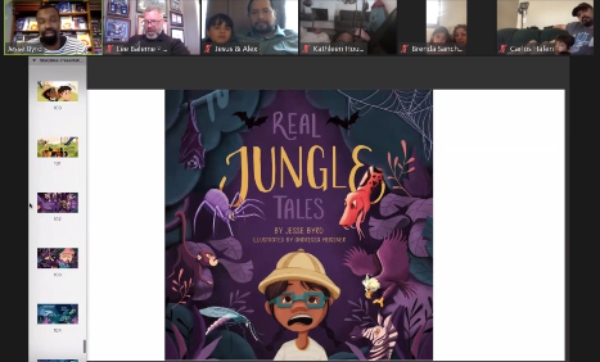Black History Month Stories to Read with Your Children All Year

Wounded warriors and their families have joined award-winning children’s book author Jesse Byrd multiple times during the last year for book readings, storytelling tips, and ways to connect with each other.
Wounded Warrior Project® (WWP) gatherings — virtual and in person — offer injured veterans the chance to form bonds with one another, their families, and their communities. These events help warriors and their families remember they’re not alone and that no matter what they’re going through, there are people who care about them and can help.
We asked Jesse to share why authentic diversity is important in storytelling and what some of his favorite stories are. Here’s what he said:
Q: Why is it beneficial for young readers of all backgrounds to read/see Black stories and Black authors?
A: Children’s books are “first stories.” These are part of the initial narratives many kids will be exposed to reflecting themselves and the world around them. Guaranteeing these stories widely and authentically reflect a range of cultures and experiences, I believe, can help kids become more empathetic and understanding of the people and circumstances around them.
The unfamiliar can seem scary. This ignorance and fear can make it easier to dehumanize (and even villainize) certain groups. Trajectories of “them versus us” become more convenient to grow into when kids haven’t been exposed to a range of narratives and images that show anyone can be smart, courageous, mischievous, curious, or powerful and not just the stereotyped demographic.
Q: In your own professional opinion, why is it significant for parents to pay attention to the book’s creator(s)?
A: I believe two really important reasons are appropriation and equity.
Regarding appropriation: Inauthentic and inaccurate depictions of a group can be more damaging than a lack of visibility. For example, minstrel shows served to dehumanize and caricaturize Black experiences. When the dominant group gets to reflect the experiences of those who have been oppressed, not ever having been in the skin of those marginalized individuals, it can warp the authenticity and accuracy of what’s being presented.
This has been a dangerous trend in publishing, where many books featuring African American characters have been both written and illustrated by people outside of the lived experience. Even for well-meaning creators and publishers, the issue is kids receiving reflections of the African American experience from those who have never been inside of it. Though no group is a monolith, having at least one person of the reflected group as the book’s author or illustrator can help produce healthier and more authentic stories for children.
Regarding equity: When marginalized groups aren’t hired to tell their own stories, someone else receives this financial and career opportunity. This takes money and a seat at the table from authors and illustrators inside the lived experiences reflected in the book while rewarding other groups for telling and selling stories on their behalf. Perhaps most insulting is there are incredible creators within those lived experiences who have been and are more than capable of telling their stories.
Q: If you were reading to elementary-school children in your own family, what books highlighting African American stories would you choose to share with them?
A: Four stories that I’ll personally read again and again are:
- Little Leaders: Bold Women in Black History by Vashti Harrison
- Brown Girl Dreaming by Jacqueline Woodson
- Crown by Derrick Barnes and Gordon C. James
- The Undefeated by Kwame Alexander & Kadir Nelson
Jesse Byrd is an award-winning children’s book author, editor, and publisher seeking to increase authentic diversity within stories for kids.
Connect with Jesse here: Instagram + Facebook + LinkedIn.
Learn more about how WWP connects warriors to build strength through community.
About Wounded Warrior Project
Since 2003, Wounded Warrior Project® (WWP) has been meeting the growing needs of warriors, their families, and caregivers — helping them achieve their highest ambition. Learn more.